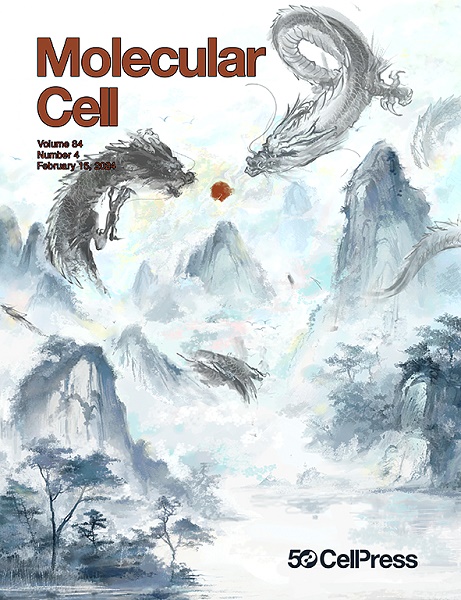Mechanism of cotranslational protein N-myristoylation in human cells
IF 14.5
1区 生物学
Q1 BIOCHEMISTRY & MOLECULAR BIOLOGY
引用次数: 0
Abstract
N-myristoyltransferases (NMTs) cotranslationally transfer the fatty acid myristic acid to the N terminus of newly synthesized proteins, regulating their function and cellular localization. These enzymes are important drug targets for the treatment of cancer and viral infections. N-myristoylation of nascent proteins occurs specifically on N-terminal glycine residues after the excision of the initiator methionine by methionine aminopeptidases (METAPs). How NMTs interact with ribosomes and gain timely and specific access to their substrates remains unknown. Here, we show that human NMT1 exchanges with METAP1 at the ribosomal tunnel exit to form an active cotranslational complex together with the nascent polypeptide-associated complex (NAC). NMT1 binding is sequence selective and specifically triggered by methionine excision, which exposes the N-myristoylation motif in the nascent chain. The revealed mode of interaction of NMT1 with NAC and the methionine-cleaved nascent protein elucidates how a specific subset of proteins can be efficiently N-myristoylated in human cells.

人细胞共翻译蛋白n -肉豆蔻酰基化的机制
N-肉豆蔻酰基转移酶(NMTs)通过共翻译将脂肪酸肉豆蔻酸转移到新合成蛋白的N端,调节其功能和细胞定位。这些酶是治疗癌症和病毒感染的重要药物靶点。在蛋氨酸氨基肽酶(METAPs)去除引发剂蛋氨酸后,新生蛋白的n -肉豆醇化特异性发生在n端甘氨酸残基上。nmt如何与核糖体相互作用并获得及时和特异性的底物通路仍然未知。在这里,我们发现人类NMT1在核糖体通道出口与METAP1交换,与新生的多肽相关复合体(NAC)形成一个活跃的共翻译复合体。NMT1结合是序列选择性的,并由蛋氨酸切除特异性触发,这暴露了新生链中的n -肉豆肉酰化基序。NMT1与NAC和蛋氨酸切割的新生蛋白相互作用的揭示模式阐明了人类细胞中特定蛋白质亚群如何有效地进行n -肉豆蔻酰基化。
本文章由计算机程序翻译,如有差异,请以英文原文为准。
求助全文
约1分钟内获得全文
求助全文
来源期刊

Molecular Cell
生物-生化与分子生物学
CiteScore
26.00
自引率
3.80%
发文量
389
审稿时长
1 months
期刊介绍:
Molecular Cell is a companion to Cell, the leading journal of biology and the highest-impact journal in the world. Launched in December 1997 and published monthly. Molecular Cell is dedicated to publishing cutting-edge research in molecular biology, focusing on fundamental cellular processes. The journal encompasses a wide range of topics, including DNA replication, recombination, and repair; Chromatin biology and genome organization; Transcription; RNA processing and decay; Non-coding RNA function; Translation; Protein folding, modification, and quality control; Signal transduction pathways; Cell cycle and checkpoints; Cell death; Autophagy; Metabolism.
 求助内容:
求助内容: 应助结果提醒方式:
应助结果提醒方式:


